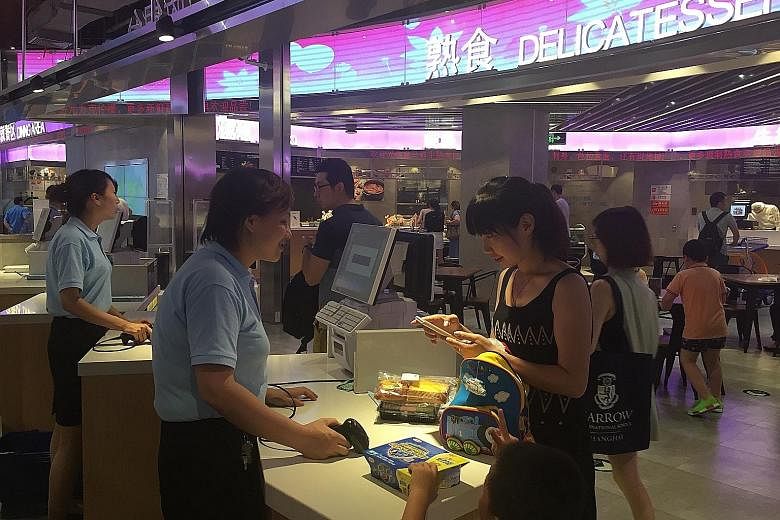Ms Sara Xue is a fan of a new supermarket in the eastern city fringe of Shanghai, in the Pudong district.
The 28-year-old instructor at a beauty clinic is attracted to the modern layout and finds it simple and convenient to pay for her purchases via her mobile phone.
Located in the basement of Jinqiao shopping mall, the six-month- old supermarket looks just like any other supermarket in the bustling commercial centre - except for one unique feature: All shoppers have to pay using Alipay. Alipay is the mobile online payment platform of China's e-commerce giant, Alibaba.
Chinese media has reported that an injection of US$1.5 billion (S$2 billion) in funds that the supermarket - He Ma Xian Sheng - received in March was linked to Alibaba.
The company, however, has not confirmed the investment.
The supermarket, which brands itself as an "experience" store exclusively for Alipay users, is a new player in China's fast-growing "online-to-offline", or O2O, market.
Taken broadly, O2O commerce is a business strategy that drives potential customers from online channels to the physical store. Examples include food delivery apps and ride-hailing apps which link customers with offline merchants.
Like many other major players in the online retail sector, Alibaba has stepped up its offline presence in search of new areas of growth in the recent two to three years.
Alibaba has in recent years invested in Koubei, a daily deals app; Didi Chuxing, a ride-hailing app; and Ele.me, a food delivery app.
China's e-commerce sales grew 22.7 per cent to hit 16.4 trillion yuan (S$3.3 trillion) last year, with the O2O sub-sector growing at 38.3 per cent, according to iResearch Consulting, a Chinese Internet market research firm. The O2O market alone was around 880 billion yuan in size, and is projected to grow at 21.8 per cent annually in the next three years to hit 1.6 trillion yuan in 2018, said the firm.
On a recent visit to He Ma Xian Sheng, this reporter saw promoters nudging shoppers to download the shopping app, with the promise of a gift or an online shopping voucher.
The Straits Times understands that online orders now make up 50 per cent of its total sales, and the supermarket will open two more outlets in the Shanghai city centre in September.
The 4,500 sq ft supermarket is also a warehouse and processing centre for online orders from customers who live within a 5km radius. Its sales assistants double as packers for online orders. Patrons are promised free delivery of the fresh products within two hours of ordering.
Last month, China's second-largest e-commerce platform, JD.com, tied up with American supermarket chain Walmart to cooperate on both online and offline retail. The US$1.5 billion deal sees JD.com taking over Walmart's online supermarket - Yihaodian - with Walmart acquiring a 5 per cent stake in the Chinese e-commerce giant.
While Walmart will continue to operate its brick-and-mortar stores, it will tap on JD.com's online delivery platform, Dada, for home deliveries. China's major online bookstore Dangdang.com, on the other hand, has decided to go it alone. Its first brick-and-mortar store is due to open in September in central Hunan's Changsha city, the company told The Straits Times. It has announced plans to open 1,000 physical stores in the next three years.

